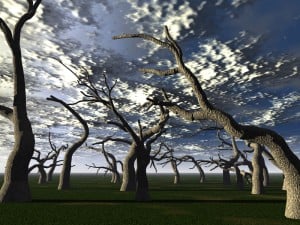Trimming the Risk of Tree Damage to Your Rental Property

Tree-related damage is usually apparent. Limbs crashing through a roof or onto automobiles or power lines are hard to miss. Sometimes the damage is so severe that entire homes are destroyed. This is especially likely to happen when large trees are torn out of the ground and topple onto a house, crashing through the structure or knocking it off its foundation.
Remarkably, extensive tree damage can also occur underground, out of sight. This happened in 1992 in the Miami-Dade County area of Florida, where trees uprooted by Hurricane Andrew caused hundreds of millions of dollars of damage to underground utilities such as sewer and water lines, buried communications cables and sidewalks.
Some trees are also notorious for aggressively sending out roots that can damage the foundation of a house, buckle sidewalks or plug up septic systems, forcing homeowners to spend thousands of dollars for repairs.
The kinds of trees in a yard, their proximity to a house and the care they receive all affect safety and the potential for damage or personal injury.
Some potential problems are easy to spot. These include:
Hollow and decayed trees.
Trees that look one-sided or lean significantly.
Branches hanging over the house near the roof.
Limbs in contact with power lines.
Mushrooms growing from the bark, indicating a decayed or weakened stem.
V-shaped forks rather than U-shaped ones. V-shaped are more likely to split.
Crossing branches that rub or interfere with one other.
Tree care professionals, including arborists, can also examine trees for more subtle signs of trouble and take care of any problems, such as the need to cut down a tree or prune limbs that might be too big, too high, or too dangerous for a homeowner to take down. Arborists can also help save trees and limbs.
Homeowners, property owners, landlords, property managers and property management companies can be the first line of defense and take steps to minimize damage to real estate property. They should regularly examine trees and check for damage or other trouble signs and take corrective action if necessary, either themselves or with the help of an expert.
Proper pruning
Good pruning can prevent many problems. Prompt removal of diseased, damaged or dead plant parts helps limit the spread of harmful insects and disease, as well as reduce the possibility of future storm damage. Pruning can also have other benefits. For instance, pruning a dense canopy reduces its mass while permitting better air circulation and sunlight penetration. Pruning also helps provide proper shape and improves the health and vigor of the plant. Do not over prune, a practice called hat racking, as this will significantly weaken a tree.
Experts offer these pruning tips:
Avoid pruning branches flush to the trunk. Doing so removes not only the limb but some of the trunk wood, opening the plant to possible decay or insect damage.
Begin by making a cut partway through the bottom of any limb to be trimmed, a few inches from the trunk. Then cut through the limb just above the first cut. This ensures that when the limb falls, it will not tear off a long strip of bark on the way down.
Finish by cutting off the few inches sticking out from the trunk. Be sure to leave the branch collar, the swollen area of trunk tissue that forms around the base of a branch. Leaving the branch collar protects the main trunk from damage.
Appropriate species
Even the best care cannot overcome poor tree selection. Some trees are more prone to storm damage than others. Also, trees that grow strong in one area might grow poorly in another. Thousands of homes have been damaged because nearby trees were wrong for the soil or region where they were planted. A shallow-rooted tree growing in soft soil, for instance, can easily topple onto a house in a strong wind. The roots will pull right out of the ground.
City foresters, county extension offices, local nurseries and landscape firms can provide advice on tree selection for your area and soil conditions. By selecting appropriate trees, planting them in the proper location and giving them the care they need, homeowners can go a long way toward not only beautifying but also protecting their property.
After a Storm
The type of care you give after a storm should depend on a tree’s age, the extent and type of damage.
To care for storm damaged trees:
In general, it is best to reset only smaller trees, since large trees will be weakened and may fall again.
Decide what to do with tree stumps.
If you are going to leave them, cut them off flush with the ground.
If you plan to remove them, leave four feet of stump standing.
Removal will be cheaper and easier if stumps can be pulled out instead of dug out.
Cut off broken or torn limbs to avoid unnecessary bark stripping.
When straightened, uprooted trees will require bracing for a long time.
Before you reset a tree, cut, smooth and paint all jagged and irregular root breaks.
Water the tree well and fertilize.
Do not remove guy wires or braces for two years.
After repairing trees, continue to care for them. Check soil moisture regularly.
Prune a damaged tree just enough to balance the loss of roots.
Cut out broken, diseased and malformed branches to give the tree a desirable shape.
Source: Institute for Business & Home Safety
To subscribe to our blog, click here.















 Accessibility
Accessibility